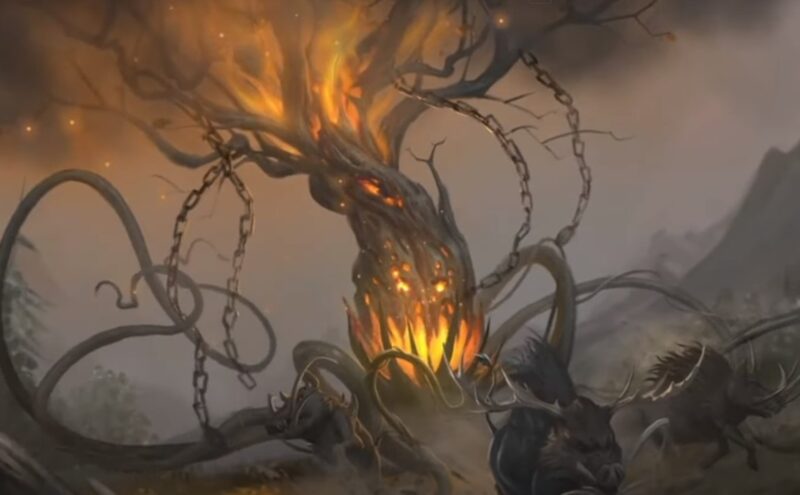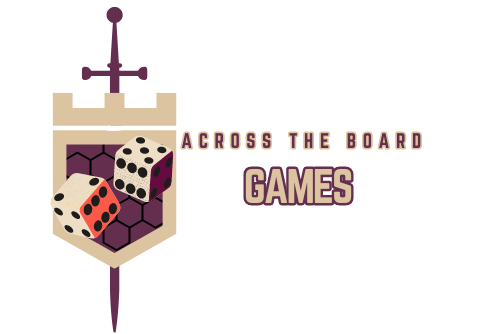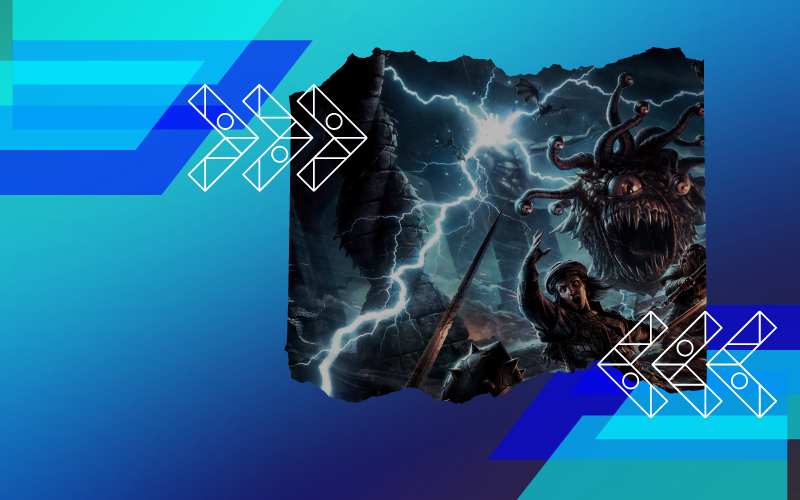The best thing about D&D is the monsters. Even more iconic than the powers, spells, races and characters are the monsters you get to fight. I polled Twitter, Facebook, and my past D&D groups and came up with a list we’re pretty comfortable calling the Top 20 Favorite Iconic D&D Monsters!
20. Vampire
Vampires have been iconic in a variety of horror and media and their influence and snazzy outfits and love of dark, dank castles made them perfect villains for Dungeons & Dragons. The most famous vampire is Count Strahd von Zarovich who was first featured in the gothic horror setting of Ravenloft.
19. Flumph

Flumphs made their first appearance in the 1981 Fiend Folio and were notable for being the only good creature featured in that monster handbook. They were instantly a joke and have probably been the basis of many references in other media such as the Flying Spaghetti Monster and Hanar from Mass Effect.
18. Mimic
Primarily used to caution players or to punish greedy ones, Mimics are creatures that shape themselves into treasure chests and wait for adventurers to stick their hands inside. They are one of the rare, more unique D&D monsters that sees a lot of use outside of D&D products.
17. Modron
Living on the abstract dimension of Mechanus, deep in the Outer Planes, the Modrons are people that resemble geometric shapes. They are crazy smart, very organized, and super goofy looking. The 90’s animated show Reboot would give them a nod with the binome creatures.
16. Drider
When I was 13 this was the coolest thing I’d ever seen painted. A spider-centaur dude. There was nothing more to say, it was just awesome. The manscorpion gets a consolation prize. You’ll probably recognize the most famous Drider pictured above as Lolth: Demon Queen of Spiders who is worshiped by the Drow.
15. Rust Monster
For some, the rust monster was intended to be an obstacle that you couldn’t use force to solve. The idea would be that instead of throwing the fighter at the problem, you would have to find another way through an area. For other DMs, the rust monster was a punishment for greedy players who felt entitled to any magic item they want.
14. Troll
The D&D troll has proven very iconic over the years, mostly because the first time you encounter one in D&D you don’t know that you have to kill it with fire or it’ll just get back up again. Like a werewolf and a silver bullet, but more green and moist.
13. Wraith
The best low level undead monsters in D&D are definitely wraiths. Zombies and skeletons are basically just slower or harder to destroy humans, and ghouls are just as boring. Wraiths sap your very life force instead of hitting you over the head with a sharp piece of metal, which has more style.
12. Gnoll
These guys get a bad rap, and I never really knew why. I love Gnolls! A band of hyena people running around being bandits and occasionally eating someone is a really compelling monster, and I wish they were used more.
11. Lich
Encountering one of these crazed, undead spellcasters will make you think twice before stealing from that skeleton sitting on a throne. Liches were first introduced during the Greyhawk setting and have been prominent in monster manuals ever since.
Their greed and lust for power makes them the perfect reminder to party members of what happens when ambition goes too far.
10. Beholder
It’s had a ton of versions and most people don’t agree which one is the best, but most D&D players appreciate the Beholder. I personally like the crazier versions- Beholders are best when they look like Far Realm denizens.
9. Gelatinous Cube
Originally created to explain why dungeons were all relatively clean of debris and bones, the Gelatinous Cube is also one of the deadliest killers in the adventuring profession. In a torch lit 10 by 10 foot hall way, the massive, clear wall of jelly is easy to run into- after which its digestive juices join the party and it’s all downhill from there.
8. Githyanki
The Githyanki (and their not-so-evil cousins the Githzerai) were basically a space-faring race of psychic humans who were twisted by eldrich powers from the darkness between the stars. Being monster psychic pirates made using them really fun, if you were ever in need of that niche.
7. Illithid
Initially a group of squid faced C’Thulhu cultists, Ilithids were heavily expanded upon to become space fantasy slavers. They were the beings responsible for changing humans into githyanki, and their psychic powers were very strong. Original squid faced pirates, only please.
6. Slaad
No, not salad. Back when making sure every section of the “alignment-associated monster grid” was filled out, some writer came up with the Slaad. They’re basically magical frogs that embody a certain element of chaos. They work best when not taken too seriously.
5. Owlbear
Some people would never put the owlbear this high up on the list, certainly not above githyanki and beholders, but hear me out. Sure, other monsters have laser eyes and silver swords and regeneration but the owlbear has got soul.
You think “oh man, that’s so dorky” because it’s an bear with an owl head, until you realize it’s still a freaking BEAR with an owl head. That’s how they get you- you underestimate them.
4. Displacer Beast
I can’t think of anyone who has played the Capcom Mystara games and not loved the design of the displacer beast. This iconic tentacled panther seems to be about three feet away from where it actually is, hence the name.
3. Tarrasque
If Dungeons & Dragons had a Godzilla, the Tarrasque would be it. It’s the size of a dragon, it’s unkillable by most magical weapons, immune to most magics and if you do ever get it down to enough negative hit points then it still takes a Wish spell to kill it (Sometimes it’ll just go to sleep instead).
One of the best things to ever use the Tarrasque was this thread on RPG.net, about a group of D&D characters who imprison the Tarrasque then build a city around it. One of the best examples of community world-building I’ve seen, too.
2. Dragons
It wouldn’t be Dungeons & Dragons with them. It is right there in the name. You really can’t get more iconic than Dragons and it doesn’t usually get much better. There are tons of stories about dragons: good ones and evil ones, wise ones and sinful ones, and D&D has your back on that.
Tiamat, the evil dragon goddess embodies vices and Bahamut, the righteous dragon god embodies virtues. Dragons that follow Tiamat are color coded (white, black, blue, red and green) while the metallic dragons tend to follow Bahamut.
1. Your Homebrew Monster
Really, the monster that you made yourself to showcase your boss monster design skills to your players is the best one. Maybe you tied it into a neat storytelling moment, or a reveal when a good character turns out to be flawed.
Whatever the case, you made the game yours and that’s the most iconic D&D thing to do, ever. (this is a drawing done many many years ago by Nicole for the giraffe-lich contest over at Obsidian Portal in case you were wondering)
FAQs
How does D&D represent mythical creatures like dragons and trolls in its gameplay?
D&D represents mythical creatures like dragons and trolls in a way that emphasizes their iconic characteristics while adding unique twists. For instance, trolls in D&D are known for their regenerative abilities, requiring players to use fire to defeat them, while dragons are color-coded and have alignments based on their color.
What are some of the most humorous or light-hearted monsters in D&D?
Some of the most humorous or light-hearted monsters in D&D include the Flumphs, which were instantly considered a joke, and the Slaad, magical frogs that embody elements of chaos. These creatures add a touch of humor and whimsy to the game.
What are some of the most feared and dreaded monsters in D&D?
Some of the most feared and dreaded monsters in D&D include the Lich, a crazed undead spellcaster, and the Tarrasque, a nearly invincible creature that is the size of a dragon. These monsters pose significant challenges and threats to players.
How does D&D use monsters to enhance the narrative and world-building aspects of the game?
D&D uses monsters to enhance the narrative and world-building aspects of the game by tying them into the game’s lore and settings. For instance, the vampire Count Strahd von Zarovich is tied to the gothic horror setting of Ravenloft, while the Githyanki and Illithids have a backstory involving space travel and psychic powers.
What are some of the most memorable and iconic monsters in D&D?
Some of the most memorable and iconic monsters in D&D include the Beholder, a creature with multiple versions, the Displacer Beast, a tentacled panther that appears to be displaced from its actual location, and the Owlbear, a creature that combines the features of an owl and a bear.
Final Words
In conclusion, the world of Dungeons & Dragons is teeming with a vast array of iconic monsters, each with its unique lore, abilities, and impact on the game. From the terrifying Tarrasque, the embodiment of destruction, to the deceptive Mimic, the game’s creatures add depth and excitement to every campaign. The list of top 20 favorite iconic D&D monsters, compiled from various sources, showcases the diversity and creativity inherent in the game.
The most iconic monster is the one you create yourself, tailored to your campaign and players, embodying the true spirit of D&D – making the game your own. Whether you’re a seasoned adventurer or a curious newcomer, these legendary creatures are a testament to the timeless allure of Dungeons & Dragons.

